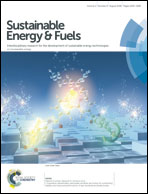A flexible membrane electrode with an electrolyte-affinity surface for energy storage: effects of amphiphilic block copolymers and membrane thickness†
Abstract
We fabricate a porous and flexible membrane electrode composed of nano-nickel hydroxide as an electrochemically active material, a polymer as a substrate material, and a copolymer as a modification additive. A series of amphiphilic block copolymers of PAA-b-PAN-b-PAA, F127, PDMC-b-PAN-b-PDMC, and PVP-b-PAN-b-PVP are prepared, and their effects on the thickness, surface structure, and electrochemical performance of the electrode materials are investigated. It is discovered that the hydrophilic chains of the amphiphilic block copolymer contribute a lot to improving the surface properties of electrolyte-affinity. The results indicate that the electrode membrane with a membrane thickness of 60 μm modified by PAA-b-PAN-b-PAA demonstrates the highest specific capacitance of 3090.0 F g−1 at a current density of 0.5 A g−1. An asymmetric supercapacitor based on the fabricated electrode membrane using Ni(OH)2 as the positive active material and activated carbon as the negative electrode obtains a capacitance of 114.1 F g−1 at 0.5 A g−1. The device shows good cycling stability with a capacitance retention of up to 90.7% after 5000 cycles at 1.0 A g−1. The maximum energy density of the asymmetrical supercapacitor reached 40.6 W h kg−1 at a power density of 400.0 W kg−1, and a high power density of 4000.0 W kg−1 was obtained at 23.5 W h kg−1 in 6 M KOH aqueous electrolyte.



 Please wait while we load your content...
Please wait while we load your content...